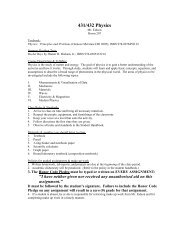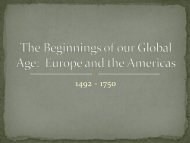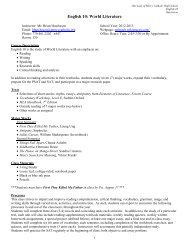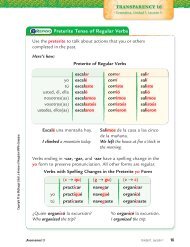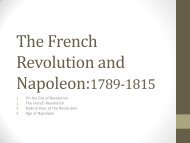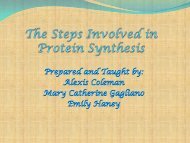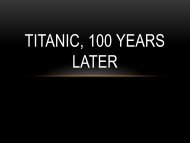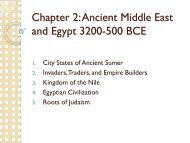Chapter 9 Physical Geography from the Andes to Amazon Chapter ...
Chapter 9 Physical Geography from the Andes to Amazon Chapter ...
Chapter 9 Physical Geography from the Andes to Amazon Chapter ...
You also want an ePaper? Increase the reach of your titles
YUMPU automatically turns print PDFs into web optimized ePapers that Google loves.
<strong>Chapter</strong> 9 <strong>Physical</strong> <strong>Geography</strong> <strong>from</strong> <strong>the</strong> <strong>Andes</strong> <strong>to</strong> <strong>Amazon</strong><strong>Chapter</strong> 10 Human <strong>Geography</strong> Blending of Cultures
<strong>Chapter</strong> 9 From <strong>the</strong> <strong>Andes</strong> <strong>to</strong> <strong>the</strong> <strong>Amazon</strong>Section 1: Landforms and ResourcesSection 2: Climate and VegetationSection 3: Human-Environment Interactions
Landforms and Resources Sierra Madre - Mexico <strong>Andes</strong> Mountains Highlands – Guiana Llanos – Columbia andVenezuela <strong>Amazon</strong> River basin – Brazil Pampas – Argentina andUruguay
Resources in Latin America Mineral deposits Include Gold, silver, iron, copper, aluminum, tin, lead, nickel Energy Reserves include Oil, coal natural gas, uranium, hydroelectric
Climate Tropical Climate Tropical Wet: Rainforest Tropical Wet and Dry:Savannahs Dry Climate Zone Semi Arid:Mexico, Brazil, Uruguay,Argentina Desert:Mexico, Chile, Argentina Mid Latitude Zones Humid Sub Tropical:Paraguay, Uruguay,Brazil Argentina MediterraneanChile Marine West CoastChile, Argentina HighlandsMountain regions
Human InteractionSlash and Burn:Terraced Farming:
UrbanizationPush Fac<strong>to</strong>rs Fac<strong>to</strong>rs pushing peopleout of <strong>the</strong> CountrysidePull Fac<strong>to</strong>rs Fac<strong>to</strong>rs pulling people<strong>to</strong> <strong>the</strong> City Poor Medical care Poor Education Low paying jobs Land ownership issues Better Medical Care Higher paying Jobs Better Schools
Tourism:Rio De Janeiro will host <strong>the</strong> 2016 OlympicsAdvantagesDis Advantages Brings in millions ofdollars Creates Jobs Spoil <strong>the</strong> land Congestion Increase in pollution
<strong>Chapter</strong> 10 Blending of CulturesSection 1: MexicoSection 2: Central America and <strong>the</strong> CaribbeanSection 3: Spanish Speaking South AmericaSection 4 Brazil
Spanish Conquest Tenochtitlan Industrial RRev1. Mexico
Colonialism and Independence Spanish First Europeans <strong>to</strong>encounter Latin America Hernan Cortez – Aztec Fransico Pissaro – Inca Spanish brought disease <strong>to</strong><strong>the</strong> new world killingmillions Enslaved <strong>the</strong> natives, Forced conversion <strong>to</strong>Christianity 1821 Mexico establishedindependence
Mexico
Long his<strong>to</strong>ry ofarchitecture and art Public art manypaintings done onbuildings Most blend Europeanand Native influencesMexican Art
Mexican Architecture Aztec and Maya builttemples and pyramids Also blend Native andEuropean influences Spanish built missionsand huge ca<strong>the</strong>drals
Economic Cities and Fac<strong>to</strong>ries Under Spanish wealth divided between richplantation owners and <strong>the</strong> landless peasants - Peons Longstanding gap between <strong>the</strong> rich and poor Mexico <strong>to</strong>day struggles with two main economicchallenges Close <strong>the</strong> gap between <strong>the</strong> rich and poor Develop a modern industrial economy Oil is a great part of <strong>the</strong> Mexican economy NAFTA North American Free Trade Agreement
Mexican Life Today Over 100 million people live in Mexico Emigration – workers travel <strong>to</strong> United States Work and School – many migrate <strong>to</strong> <strong>the</strong> UnitedStates with out education Mexico is making strides in education, 85 percent ofchildren of age are in school Need <strong>to</strong> increase spending on education <strong>to</strong> improveconditions for young people
Central America and TheCaribbean Cultural Hearth United province of Central America Panama Canal Calypso Reggae Informal economy
Native Central America: Maya A Cultural Hearth a crossroads of cultures betweenNorth America and South America Mayan built a great civilization and it spread south They Abandoned <strong>the</strong>ir cities about 800 A.D. still amystery Built many cities and temples in Belize, HondurasGuatemala and El Salvador Ruled by a God King
Colonial Central America: Spanish Conquest of <strong>the</strong> Aztec opened <strong>the</strong> door <strong>to</strong> Spanishdominance until 19 th century Mexico originally <strong>to</strong>ok <strong>the</strong> name United Provinces ofCentral America included all of Mexico and CentralAmerica 1830 split apart and became separate nations. CostaRica, Guatemala, Nicaragua Honduras, and ElSalvador Later Panama would break <strong>from</strong> Columbia Belize a former British colony became independent
Mexico and Central America
Native Caribbean First claimed by Chris<strong>to</strong>pher Columbus 1492 Encountered <strong>the</strong> Tainos who he named Indians Spanish settled some islands and establishedplantations Enslave natives <strong>to</strong> work many died Imported Slave labor <strong>to</strong> replace <strong>the</strong> workforce This led <strong>to</strong> a lasting influence of African culture Island claimed by Spanish, French, British, Dutchand Danish all imported slaves
Map of <strong>the</strong> Caribbean
Caribbean Independence First Independence came as a slave revolt in Haiti Revolt <strong>to</strong>ok over <strong>the</strong> government in 1804 <strong>from</strong>France Cuba later became independent <strong>from</strong> Spain 1898 Jamaica, Trinidad and Tobago did not becomeindependent until1962 <strong>from</strong> Great Britain
Cultural Blend Culture of Central America: Combines Native Elements and European influences Spanish remains <strong>the</strong> dominate language, with French andEnglish. Some Dutch and Danish Strong Catholic traditions but <strong>the</strong>re are some protestantmissionaries Culture of <strong>the</strong> Caribbean: Great variety of influence African influence left a great mark on <strong>the</strong> islands Religion include Catholic, Protestant and Santeria Voodoo on Haiti Rastafarianism on Jamaica
Economics: Jobs and CitiesFarming and Trade Sugar Cain provideslargest export crop Banana, citrus fruit,<strong>to</strong>bacco, coffee, spices Low pay for farmworkers Panama CanalWhere people live andwhy Population related <strong>to</strong>economies Between 30-40 million Many islands citiesdensely populated Tourism large part ofeconomy
Popular Culture, Tourism and<strong>the</strong> informal economy Music: elements of Spanish and African influence Calypso: began in Trinidad steel drums and guitars Reggae: developed in Jamaica in <strong>the</strong> 1960’s Deal with social problems Bob Marley Tourism: Increasingly important Informal economy: Out side of official channels Street vendors shoe shinners
3. Spanish Speaking South America Inca Quechua Mercosur
Spanish Speaking South America? Spain and Portugaldisputed land claims Pope Alexander VIIntervened Line of Demarcation Both Counties signedlater The Treaty ofTordesilles splitting <strong>the</strong>continent West is Spanish, East isPortuguese
Warrior culture Conquered <strong>the</strong> westcoast of South America Built an advancedcivilization in <strong>the</strong>mountains By 1500 <strong>the</strong> Empireextend 2500 milesThe Inca
The Spanish Conquest Francisco Pissarroinvaded and conquer<strong>the</strong> Inca Forced <strong>the</strong> natives <strong>to</strong>work as slaves Forced <strong>the</strong> Inca <strong>to</strong> move<strong>to</strong> plantations <strong>from</strong><strong>the</strong>ir villages Spanish Forced <strong>the</strong>irown language whichreplaced Quechua Replaced <strong>the</strong> nativereligion withCatholicism One of <strong>the</strong> onlycivilizations conqueredstill seen <strong>to</strong>day
Independence Movement Columbia Venezuela Ecuador BoliviaSimon Bolivar Once Independencewas gain <strong>the</strong> countriesfailed <strong>to</strong> work <strong>to</strong>ge<strong>the</strong>rJose de San Martin Argentina Chile Peru Argentina and Chilefirst <strong>to</strong> receiveIndependence
Many governments ei<strong>the</strong>r Oligarchy or militaristic Authoritarian rule demands obedience overindividual freedom Years of colonialism had it effects Strong militaries Underdeveloped economies Social class divisionGovernment
Most economies based on agriculture Huge income gap between <strong>the</strong> rich and poor This is due <strong>to</strong> <strong>the</strong> failure <strong>to</strong> develop economicallyafter <strong>the</strong>ir independence Does produce a wide variety of products Crops Oil FishingEconomics
Chile’s Success S<strong>to</strong>ry Trades its goods with nations as far away as Japan Exports Fruits and Vegetables <strong>to</strong> North America Has huge deposits of copper Is <strong>the</strong> leader in working on improving <strong>the</strong> economicenvironment in South America




